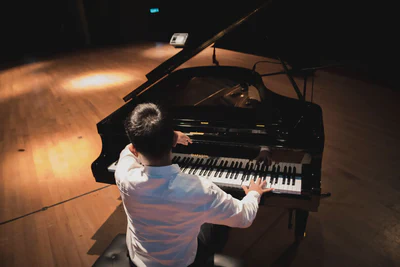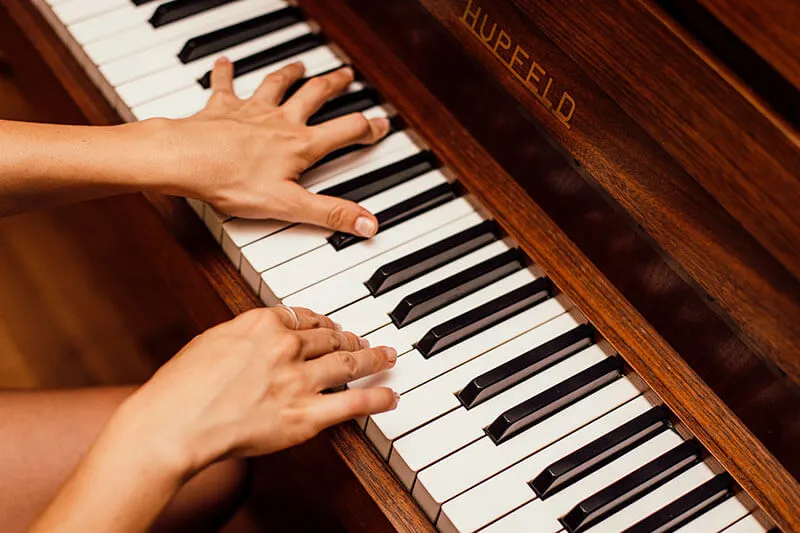Practice
Recommendations for my students
- Practice daily (at least 4-5 days per week) for 15-60 minutes or more depending upon your age and level of advancement. Remember, it is better to have 30 minutes of correct practice, than 60 minutes of incorrect practice.
Quality of practice is more important than length of practice.

Put a clock on your piano. Always make sure you divide your time between all the pieces of your program. Start with the most complicated piece, or with the one which I asked you to practice more.
Never choose a fast tempo in the beginning, concentrate on the clarity, texture, and voicing of each musical phrase. Increase the tempo slowly as you improve. Never forget that multiple repetitions of a phrase, and later of the whole piece, is the key to your success.
When you work on polyphonic music, play each voice separately, then try to combine pairs of voices, and later play all the voices together. So much fun!
If you use the damper pedal, make sure you can still hear the original composer’s chords and clear melodic line. Some students forget to release the pedal!
Understanding of style and specific details of the pieces you are working on require some knowledge of the time, époque, and biography. Read some books on music, musicians, and music history - it will help you to understand the music that you are playing.
ADVICE FOR BEGINNERS

- FIND A GOOD TEACHER
A good first teacher will have two things: a record or history of producing successful students and experience teaching children. The best instructor for your child may not be the one with the highest official prestige (such as a faculty position at a university), high teaching quality is a combination of: training, educational background, and dedication to the piano. These are the most important things to look for in an Instructor. You can get information about the teachers by contacting them directly, by reading about them on their web page, and speaking with parents, whose children are currently taking lessons from them. Don’t be afraid about asking for references. When you speak with the prospective teacher, let them know your desired results and what kind of piano experience you are hoping to give your child.
- BUY A GOOD PIANO
Ideally, your child should have a nice instrument from day one. However, since nice instruments can run anywhere between $30,000 to $50,000 (depending on the size and brand), this might not be financially realistic for a beginning student. Therefore, it’s perfectly OK for your child’s first piano to be an upright, provided that it has a crisp, full sound that doesn’t boom or echo and all the keys and pedals work properly.
Before you decide to purchase, you should test pianos extensively before buying to figure out which brands you like and what you should pay for them. After the purchase, you will need to find a piano tuner to recalibrate the instrument twice a year and make repairs when necessary.
That said, you should keep in mind that your child may eventually require a high-quality grand piano, preferably by age 10 if they are exceptionally talented, and you feel it would be worth the expense.
- START EARLY - AGE FIVE OR YOUNGER
Nothing can substitute for early age; even a one-year delay makes a huge difference on the level of or quality of performance your child may achieve. Age four or five is ideal; the secret is the attention span for your child.
The piano is an experience-based activity; the earlier you start, the more time your child will have to get comfortable with the instrument. The earlier you start, the more “natural” playing will feel to your child. The more “natural” the feel … the more “natural” the music will sound.
- PRACTICE, PRACTICE, PRACTICE AND MORE PRACTICE
Unfortunately, practice is necessary. Like anything worthwhile , the more you put into it, the more you will get out of it. However, this does not mean you need to practice 6 hours a day. 30 minutes of correct practice (focused and deliberate concentration) to learn a specific technique or pattern is more important than 2 hours of incorrect practice. (Which is wasted time and reinforcing bad technique.)
The length of practice time you should do will depend upon the proficiency level desired and how quickly you wish to get there.
- ENFORCE FLAWLESS TECHNIQUE
If your teacher is good, they will focus entirely and maniacally on technique during the first two years. (If your teacher refuses to talk about technique or doesn’t seem strict about it, you need to find a new teacher immediately.) There’s a whole method for how to touch the keyboard, distribute your weight, and hold and move your fingers before you play a single note.
After you start working on exercises, the only way to establish solid technique is to play everything slowly. One-Note-at-a-Time. Play each exercise at least 3 - 5 times at that slow speed. If you can’t maintain a steady rhythm, use a metronome. You can speed up gradually, but not before you feel completely comfortable doing things slowly, fluidly, and accurately. The reason for this technique is: the slightest technical mistake or problem in the beginning, when slow, will lead to a garbled mess when you speed things speed up to normal speed.
Your child may hate this, but might be necessary for you to watch your child practice to make sure they are practicing correctly.
- FIND FUN, CHALLENGING REPERTOIRE
Aside from scales and other the all-important exercises, your teacher should assign interesting and challenging songs for your child to learn and to perform at recitals/competitions. A good teacher should explain a little bit about the piece, including some musical history, and perhaps a short story about each song, before going into more detailed explanations of dynamics and phrasing. In the beginning, the pieces will be very basic, but with time and practice, your child’s pieces will become more complicated. Regardless of their difficulty, your teacher should find professional recordings of the pieces so you and your child can gain a clear understanding of what the piece should sound like. It is important that your child plays and masters the piece perfectly before letting them advance to harder pieces.
- DEFINE GOOD GOALS
You need to decide what type of piano experience you want your child to have. This includes both short-term and long-term. When planning your goals, you can be ambitious …. but make sure you are realistic. More than likely your child will not win the Van Cliburn competition at age 10, but with talent and practice, they will be able to produce a beautiful rendition of Beethoven’s “Moonlight Sonata.”
In the beginning, it’s best to make small, short-term goals. As your child advances, if concerts and competitions are part of your plan, you and your teacher need to choose the repertoire in advance. This process could even take place months or even a year before the event.
- MAXIMIZE THE PERFORMING EXPERIENCE
One of the scariest aspects of playing piano is performing in recitals or concerts. Performing live scares the crap out of most people, so your child needs to learn to play for audiences. Starting early and performing often as possible will help desensitize your child. Performances also help your child by establishing deadlines. They need to do this … by that date. Your teacher should offer many opportunities for your child to perform. Make sure your child practices in the months/weeks preceding each performance. If your child works hard enough, they will be prepared. If they are prepared, they will be confident. If they are confident …. their performances will turn out to be very gratifying and with no mistakes.
- INSPIRE WITH GOOD EXAMPLES
Your child needs to see, from an early age, what good pianists are capable of. For a child, nothing is more inspiring than live performances. So don’t hesitate to take your child to as many piano performances, advanced student recitals, and solo concerts as you can afford. You should also let your child to listen to CDs and watch concerts on TV. Give them a higher level example.
- TAKE AN OCCASIONAL BREAK
Everybody needs to recharge and take an occasional break. For most students, this means summer. By “occasional,” I mean once a year, and by “break,” I mean practicing less than usual. Not stopping everything or going cold turkey. Their technique should deteriorate slightly, but the primary reason for the break is to give them a mental rest. Not a physical rest.
KNOW WHEN TO QUIT
This step isn’t part of the process. Although I have dedicated my life to teaching the piano, I do realize the piano is not for everyone. Learning the piano can be frustrating. Practicing is not fun for any young child. Children always want to quit. After all … they are children. They just do not know how much they will appreciate their ability when they will be adults. I’m talk about quitting when no amount of practice and instruction can overcome a lack of ability. If your child is musically untalented, you need to be able to recognize, accept it.
Another reason to quit: if your child is at least 14 years old, has achieved a good level of proficiency, and still hates piano–not just verbally, because kids will complain about anything–but genuinely derives no joy from practicing or performing, you need to reconsider their lessons. Your child’s feelings will never improve. You will be wasting their time, the teacher’s time, and your money.